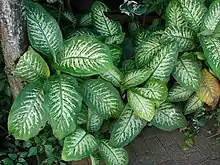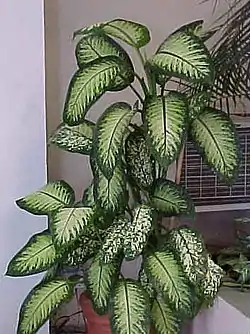Dieffenbachia seguine
Dieffenbach seguine, also known as dumbcane,[1] or tuftroot,[2] is a species of Dieffenbachia native to the tropical Americas—from southern Mexico, through Central America, to northern South America and Brazil.[1] It is also native to several Caribbean islands, including Puerto Rico.[1]
| Dumbcane | |
|---|---|
 | |
| Scientific classification | |
| Kingdom: | Plantae |
| Clade: | Tracheophytes |
| Clade: | Angiosperms |
| Clade: | Monocots |
| Order: | Alismatales |
| Family: | Araceae |
| Genus: | Dieffenbachia |
| Species: | D. seguine |
| Binomial name | |
| Dieffenbachia seguine | |
| Synonyms | |
|
Dieffenbachia amoena | |
Description
The herbaceous perennial grows 3 feet (0.91 m) to 10 feet (3.0 m) in height and 2 feet (0.61 m) to 3 feet (0.91 m) in width.[3] The plant's leaves are large and green, and often with variegated white patterns. Like other Dieffenbachias, the sap is toxic. It has showy white flowers.[3]
Cultivation
Dieffenbachia seguine is cultivated as an ornamental plant in temperate shade gardens and as a potted house plant.[3] Cultivars emphasize different patterns of variegation.

References
- USDA, NRCS (n.d.). "Dieffenbachia seguine". The PLANTS Database (plants.usda.gov). Greensboro, North Carolina: National Plant Data Team. Retrieved 17 January 2016.
- "Plants & Flowers » Tuftroot". Retrieved 2 June 2021.
- Missouri Botanic Garden . accessed 10.20.2011